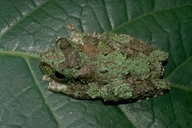|
Distribution and Habitat
Country distribution from AmphibiaWeb's database: Indonesia, Papua New Guinea
Queensland Wet Tropics.
The extent of occurrence of the species is approximately 20000 km2
Life History, Abundance, Activity, and Special Behaviors
Associated with rainforest streams and rocky creek beds.
Breeding starts in August. Egg clumps of 843 eggs in a firm jelly have been recorded, laid in a
pool.
Trends and Threats
Declines have been noted in the Wet Tropics and extent of occurrence is approximately
20,000km2.
Threats
Declines have been noted in Wet Tropics. Chytrid fungus or a virus is suspected to have
caused sudden declines.
Conservation Measures
A recovery plan for the frog species in the Wet Tropics has been written and this species will
benefit from that. Protected in the National Parks in the region.
References
Barker, J., Grigg, G. C., and Tyler, M. J. (1995). A Field Guide to Australian Frogs. Surrey Beatty and Sons, New South Wales.
McDonald, K. and Alford, R. (1999). ''A review of declining frogs in northern Queensland.'' Declines and Disappearances of Australian Frogs. A. Campbell, eds., Environment Australia, Canberra. Available in .pdf format online.
Northern Queensland Recovery Team (2000). ''Recovery Plan for the Stream-Dwelling Rainforest Frogs of the West Tropics Biogeographic Region of North-east Queensland.''
Originally submitted by: Jean-Marc Hero et. al. (first posted 2002-04-05)
Edited by: Ambika Sopory, Jean-Marc Hero (2008-09-16)Species Account Citation: AmphibiaWeb 2008 Litoria genimaculata: Green-eyed Treefrog <https://amphibiaweb.org/species/1252> University of California, Berkeley, CA, USA. Accessed Jan 14, 2025.
Feedback or comments about this page.
Citation: AmphibiaWeb. 2025. <https://amphibiaweb.org> University of California, Berkeley, CA, USA. Accessed 14 Jan 2025.
AmphibiaWeb's policy on data use.
| 





 Map of Life
Map of Life